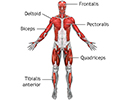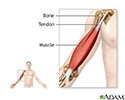Becker muscular dystrophy
Benign pseudohypertrophic muscular dystrophy; Becker's dystrophyBecker muscular dystrophy is an inherited disorder that involves slowly worsening muscle weakness of the legs and pelvis.
Muscle weakness
Weakness is reduced strength in one or more muscles.

Causes
Becker muscular dystrophy is very similar to Duchenne muscular dystrophy. The main difference is that it gets worse at a much slower rate and it is less common. This disease is caused by a mutation in the gene that encodes a protein called dystrophin.
Duchenne muscular dystrophy
Duchenne muscular dystrophy is an inherited disorder. It involves muscle weakness, which quickly gets worse.

The disorder is passed down through families (inherited). Having a family history of the condition raises your risk.
Becker muscular dystrophy occurs in about 3 to 6 out of every 100,000 births. The disease is found mostly in boys.
Symptoms
Females rarely develop symptoms. Males will develop symptoms if they inherit the defective gene. Symptoms most often appear in boys between ages 5 and 15, but may begin later.
Muscle weakness of the lower body, including the legs and pelvis area, slowly gets worse, causing:
- Difficulty walking that gets worse over time; by age 25 to 30, the person is usually unable to walk
- Frequent falls
- Difficulty getting up from the floor and climbing stairs
- Difficulty with running, hopping, and jumping
- Loss of muscle mass
- Toe walking
- Muscle weakness in the arms, neck, and other areas is not as severe as in the lower body
Other symptoms may include:
- Breathing problems
- Cognitive problems (these do not get worse over time)
-
Fatigue
Fatigue
Fatigue is a feeling of weariness, tiredness, or lack of energy.
 ImageRead Article Now Book Mark Article
ImageRead Article Now Book Mark Article - Loss of balance and coordination
Exams and Tests
The health care provider will do a nervous system (neurological) and muscle exam. A careful medical history is also important, because symptoms are similar to those of Duchenne muscular dystrophy. However, Becker muscular dystrophy gets worse much more slowly.
An exam may find:
- Abnormally developed bones, leading to deformities of the chest and back (scoliosis)
Scoliosis
Scoliosis is an abnormal curving of the spine. Your spine is your backbone. It runs straight down your back. Everyone's spine naturally curves a b...
 ImageRead Article Now Book Mark Article
ImageRead Article Now Book Mark Article - Abnormal heart muscle function (cardiomyopathy)
Cardiomyopathy
Cardiomyopathy is disease in which the heart muscle becomes weakened, stretched, or has another structural problem. It often contributes to the hear...
 ImageRead Article Now Book Mark Article
ImageRead Article Now Book Mark Article -
Congestive heart failure or irregular heartbeat (arrhythmia) - rare
Congestive heart failure
Heart failure is a condition in which the heart is no longer able to pump oxygen-rich blood to the rest of the body efficiently. This causes symptom...
 ImageRead Article Now Book Mark Article
ImageRead Article Now Book Mark ArticleArrhythmia
An arrhythmia is a disorder of the heart rate (pulse) or heart rhythm. The heart can beat too fast (tachycardia), too slow (bradycardia), or irregul...
 ImageRead Article Now Book Mark Article
ImageRead Article Now Book Mark Article - Muscle deformities, including contractures of heels and legs, abnormal fat and connective tissue in calf muscles
Contractures
A contracture develops when normally stretchy (elastic) tissues are replaced by nonstretchy (inelastic) fiber-like tissue. This tissue makes it hard...
 ImageRead Article Now Book Mark Article
ImageRead Article Now Book Mark Article - Muscle loss that begins in the legs and pelvis, then moves to the muscles of the shoulders, neck, arms, and respiratory system
Tests that may be done include:
-
Creatine phosphokinase (CPK) and other blood tests
Creatine phosphokinase
Creatine phosphokinase (CPK) is an enzyme in the body. It is found mainly in the heart, brain, and skeletal muscle. This article discusses the test...
 ImageRead Article Now Book Mark Article
ImageRead Article Now Book Mark Article -
Electromyography (EMG) nerve testing
Electromyography
Electromyography (EMG) is a test that checks the health of the muscles and the nerves that control the muscles.
 ImageRead Article Now Book Mark Article
ImageRead Article Now Book Mark Article -
Muscle biopsy
Muscle biopsy
A muscle biopsy is the removal of a small piece of muscle tissue for examination.
 ImageRead Article Now Book Mark Article
ImageRead Article Now Book Mark Article - Genetic test
- Echocardiogram and electrocardiogram (ECG)
Treatment
There is no known cure for Becker muscular dystrophy. However there are many new medicines currently undergoing clinical testing that show significant promise in treating the disease. The current goal of treatment is to control symptoms to maximize the person's quality of life. Some providers prescribe steroids to help keep a patient walking for as long as possible.
Activity is encouraged. Inactivity (such as bed rest) can make the muscle disease worse. Physical therapy may be helpful to maintain muscle strength. Orthopedic appliances such as braces and wheelchairs may improve movement and self-care.
Abnormal heart function may require the use of a pacemaker or defibrillator.
Genetic counseling may be recommended. Daughters of a man with Becker muscular dystrophy will very likely carry the defective gene and could pass it on to their sons.
Support Groups
You can ease the stress of the illness by joining a muscular dystrophy support group where members share common experiences and problems.
Stress
Stress is a feeling of emotional or physical tension. It can come from any event or thought that makes you feel frustrated, angry, or nervous. Stres...

Muscular dystrophy support group
The following organizations are good resources for information on muscular dystrophy:Centers for Disease Control and Prevention -- www. cdc. gov/musc...

Outlook (Prognosis)
Becker muscular dystrophy leads to slowly worsening disability. However, the amount of disability varies. Some people may need a wheelchair. Others may only need to use walking aids such as canes or braces.
Lifespan is most often shortened if there are heart and breathing problems.
Possible Complications
Complications may include:
- Heart-related problems such as cardiomyopathy
- Lung failure
-
Pneumonia or other respiratory infections
Pneumonia
Pneumonia is inflamed or swollen lung tissue due to infection with a germ. This article covers community-acquired pneumonia (CAP). This type of pneu...
 ImageRead Article Now Book Mark Article
ImageRead Article Now Book Mark ArticleRespiratory
The words "respiratory" and "respiration" refer to the lungs and breathing.
 ImageRead Article Now Book Mark Article
ImageRead Article Now Book Mark Article - Increasing and permanent disability that leads to decreased ability to care for self, decreased mobility
When to Contact a Medical Professional
Contact your provider if:
- Symptoms of Becker muscular dystrophy appear
- A person with Becker muscular dystrophy develops new symptoms (particularly fever with cough or breathing difficulties)
Fever
Fever is the temporary increase in the body's temperature in response to a disease or illness. A child has a fever when the temperature is at or abov...
 ImageRead Article Now Book Mark Article
ImageRead Article Now Book Mark ArticleCough
Coughing is an important way to keep your throat and airways clear. But too much coughing may mean you have a disease or disorder. Some coughs are d...
 ImageRead Article Now Book Mark Article
ImageRead Article Now Book Mark ArticleBreathing difficulties
Breathing difficulty may involve:Difficult breathing Uncomfortable breathingFeeling like you are not getting enough air
 ImageRead Article Now Book Mark Article
ImageRead Article Now Book Mark Article - You are planning to start a family and you or other family members have been diagnosed with Becker muscular dystrophy
Prevention
Genetic counseling may be advised if there is a family history of Becker muscular dystrophy.
References
Doughty CT, Amato AA. Disorders of skeletal muscle. In: Jankovic J, Mazziotta JC, Pomeroy SL, Newman NJ, eds. Bradley and Daroff's Neurology in Clinical Practice. 8th ed. Philadelphia, PA: Elsevier; 2022:chap 109.
Gloss D, Moxley RT III, Ashwal S, Oskoui M. Practice guideline update summary: corticosteroid treatment of Duchenne muscular dystrophy: report of the Guideline Development Subcommittee of the American Academy of Neurology. Neurology. 2016;86(5):465-472. PMID: 26833937 pubmed.ncbi.nlm.nih.gov/26833937/.
Manzur AY. Muscular dystrophies In: Kliegman RM, St. Geme JW, Blum NJ, et al, eds. Nelson Textbook of Pediatrics. 22nd ed. Philadelphia, PA: Elsevier; 2025:chap 649.
Selcen D. Muscle diseases. In: Goldman L, Cooney KA, eds. Goldman-Cecil Medicine. 27th ed. Philadelphia, PA: Elsevier; 2024:chap 389.
-
Superficial anterior muscles - illustration
Superficial muscles are close to the surface of the skin. Muscles which lie closer to bone or internal organs are called deep muscles.
Superficial anterior muscles
illustration
-
Deep anterior muscles - illustration
Muscle tissue is composed primarily of contractile cells. Contractile cells have the ability to produce movement.
Deep anterior muscles
illustration
-
Tendons and muscles - illustration
Tendons connect muscles to their bony origins and insertions.
Tendons and muscles
illustration
-
Lower leg muscles - illustration
The muscular components of the lower leg include the gastrocnemius, soleus, peroneus longus, tibialis anterior, extensor digitorum longus, and the Achilles tendon.
Lower leg muscles
illustration
-
Superficial anterior muscles - illustration
Superficial muscles are close to the surface of the skin. Muscles which lie closer to bone or internal organs are called deep muscles.
Superficial anterior muscles
illustration
-
Deep anterior muscles - illustration
Muscle tissue is composed primarily of contractile cells. Contractile cells have the ability to produce movement.
Deep anterior muscles
illustration
-
Tendons and muscles - illustration
Tendons connect muscles to their bony origins and insertions.
Tendons and muscles
illustration
-
Lower leg muscles - illustration
The muscular components of the lower leg include the gastrocnemius, soleus, peroneus longus, tibialis anterior, extensor digitorum longus, and the Achilles tendon.
Lower leg muscles
illustration
Review Date: 3/31/2024
Reviewed By: Joseph V. Campellone, MD, Department of Neurology, Cooper Medical School at Rowan University, Camden, NJ. Review provided by VeriMed Healthcare Network. Also reviewed by David C. Dugdale, MD, Medical Director, Brenda Conaway, Editorial Director, and the A.D.A.M. Editorial team.





